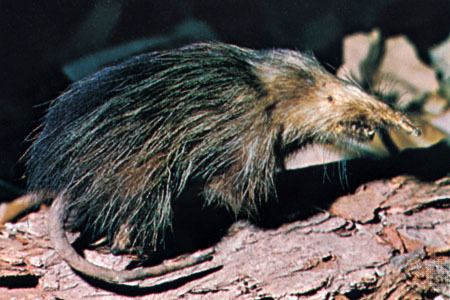Genus Solenodon Higher classification Solenodon | Phylum Chordata Scientific name Solenodon cubanus Rank Species | |
 | ||
Similar Solenodon, Hispaniolan solenodon, Mammal, Eulipotyphla, Soricomorpha | ||
The Cuban solenodon or almiqui (Solenodon cubanus), is a species of soricomorph endemic to Cuba. It belongs to the family Solenodontidae along with a similar species, the Hispaniolan solenodon (Solenodon paradoxus). The solenodon is unusual among mammals in that its saliva is venomous.
Contents

Rediscovery

Since its discovery in 1861 by the German naturalist Wilhelm Peters, only 36 had ever been caught. By 1970, some thought the Cuban solenodon had become extinct, since no specimens had been found since 1890. Three were captured in 1974 and 1975, and subsequent surveys showed it still occurred in many places in central and western Oriente Province, at the eastern end of Cuba; however, it is rare everywhere. Prior to 2003, the most recent sighting was in 1999, mainly because it is a nocturnal burrower, living underground, and thus is very rarely seen. The Cuban solenodon found in 2003, named Alejandrito, brought the number ever caught to 37. It had a mass of 24 oz (0.68 kg) and was healthy. It was released back into the wild after two days of scientific study were completed.
Appearance

With small eyes, and dark brown to black hair, the Cuban solenodon is sometimes compared to a shrew, although it most closely resembles members of the family Tenrecidae, of Madagascar. It is 16–22 in (41–56 cm) long from nose to tail-tip and resembles a large brown rat with an extremely elongated snout and a long, naked, scaly tail.
Status

The Cuban solenodon was declared extinct in 1970, but was rediscovered in 1974. Since 1982, it has been listed as an endangered species, in part because it only breeds a single litter of one to three in a year, and because of predation by the invasive small Asian mongoose introduced by humans.
Distribution
The home range of the Cuban solenodon is currently in Cuba only. Historically, this animal was distributed all across North America. This is supported by the fossil records that are found in North America. This species is nocturnal and it travels at night along the forest floor, looking for insects and small animals on which to feed.
Behavior

This species has a varied diet. At night, they search the forest floor litter for insects and other invertebrates, fungi, and roots. They climb well and feed on fruits, berries, and buds, but have more predatory habits, too. With venom.from modified salivary glands in the lower jaw, they can kill lizards, frogs, small birds, or even rodents. They seem not to be immune to the venom of their own kind, and cage mates have been reported dying after fights.
Mating
This species of animals are polygamist which means they only meet up to mate and the male mates with multiple females. The males and females are not found together unless they are mating. The pair will meet up, mate, then separate. The males do not partake in raising any of the young.
